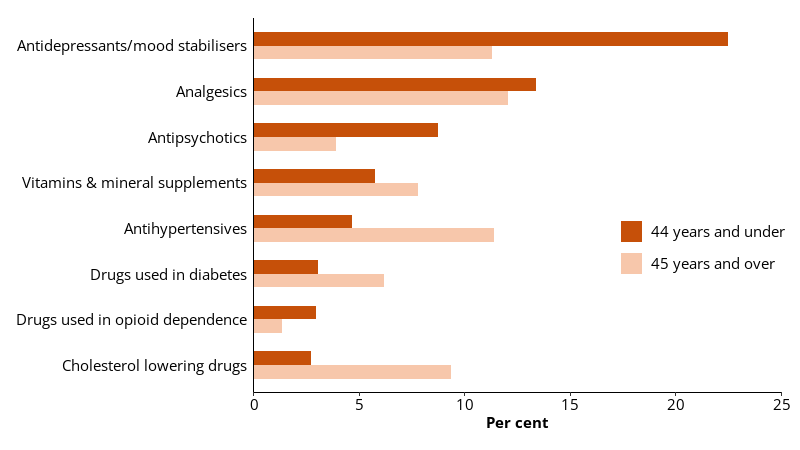Medications dispensed in custody
The National Prisoner Health Data Collection (NPHDC) medication form was used to obtain data on prescription medications given to incarcerated individuals on a single day during the data collection period in 2022. This provided a snapshot of the medications typically dispensed by prison clinics.
To calculate the proportion of people dispensed medication in custody, a snapshot of prison population data for the facilities that participated in the 2022 NPHDC was obtained from the ABS for use as a denominator.
However, the results may underestimate the true proportions of incarcerated individuals taking prescription medication, as not all prison clinics were able to capture all dispensed medications.
Around 1 in 4 (27%) people in custody were dispensed prescription medication on a snapshot day in prison (Indicator 3.3.1).
Nearly one-third (31%) of females in prison, and nearly one-quarter (22%) of males in prison, were dispensed prescription medication in 2022 on a snapshot day (Table 12.1).
On average, each person in custody who received medication was dispensed 2.93 medications, with females receiving more on average (3.32 medications) than males (2.96 medications). In total, approximately 20,896 medications were dispensed to 7,130 individuals in custody on a single snapshot day during the 2022 NPHDC (Table 12.1).
Measure | Males | Females | People |
|---|---|---|---|
Number of people in custody dispensed medication | 5,263 | 659 | 7,130 |
Number of medications dispensed | 15,567 | 2,185 | 20,896 |
Number of people in custody | 24,515 | 2,148 | 26,663 |
Percentage of people in custody dispensed medication (%) | 21.5 | 30.7 | 26.7 |
Average number of medications dispensed per person dispensed any medication | 2.96 | 3.32 | 2.93 |
Notes
- Totals include unknowns.
- Excludes Victoria, which did not provide data for this item.
- Numbers are representative of this data collection only, and not the entire prison population.
Source: Medication form, 2022 NPHDC; data supplied by the ABS.
Medications dispensed by prison clinics were assigned to 23 categories. The most commonly dispensed medication types were:
- antidepressants/mood stabilisers (for example, sertraline, fluoxetine) (18%)
- analgesics (for example, paracetamol, codeine or oxycodone) (13%)
- anti-inflammatories/anti-rheumatic agents (for example, ibuprofen, aspirin) (9.0%)
- drugs associated with digestive system disorders, such as antiemetics, anti-nauseants, laxatives, and anti-diarrhoeals (8.1%)
- antihypertensive and beta-blocking medications (for example, perindopril, ramipril) (7.4%) (Table 12.2).
Medication category | Number | % |
|---|---|---|
Antidepressants/mood stabilisers | 3,770 | 18.0 |
Analgesics | 2,677 | 12.8 |
Anti-inflammatories/anti-rheumatic agents | 1,881 | 9.0 |
Drugs used in acid-related disorders, antiemetics, anti-nauseants, laxatives, antidiarrhoeals | 1,684 | 8.1 |
Antihypertensives, beta blocking agents | 1,550 | 7.4 |
Antipsychotics | 1,423 | 6.8 |
Vitamins and mineral supplements | 1,386 | 6.6 |
Cholesterol-lowering drugs (lipid modifying agents) | 1,134 | 5.4 |
Asthma relievers, preventers, symptom controllers (drugs for obstructed airway) | 738 | 3.5 |
Drugs used in diabetes | 920 | 4.4 |
Dermatologicals (skin, including antifungals) | 553 | 2.6 |
Drugs used in opioid dependence | 485 | 2.3 |
Antihistamines | 476 | 2.3 |
Antiepileptics, anti-Parkinson drugs | 391 | 1.9 |
Antibiotics | 270 | 1.3 |
Hepatitis, antivirals for HIV, infectious diseases | 245 | 1.2 |
Diuretics | 172 | 0.8 |
Hypnotics and sedatives | 132 | 0.6 |
Thyroid therapy | 103 | 0.5 |
Anti-anxiety (anxiolytics) | 87 | 0.4 |
Drugs used in benign prostatic hypertrophy (prostate) | 73 | 0.3 |
Drugs used in nicotine dependence | 33 | 0.2 |
Other | 713 | 3.4 |
Total prescription medications dispensed | 20,896 | 100.0 |
Notes
- Excludes Victoria, which did not provide data for this item.
- Percentages may not sum to the total due to rounding.
- Numbers are representative of this data collection only, and not the entire prison population.
Source: Medication form, 2022 NPHDC.
The proportions of medications dispensed to people in prison differed by age, reflecting the differing conditions that affect each population (Figure 12.1). Indigenous identity and sex were not factors that greatly influenced the types of medications dispensed.
Figure 12.1: Prescription medications dispensed to people in custody, by age group and type of medication, 2022

Notes
- Proportions are representative of this data collection only, and not the entire prison population.
- Excludes Victoria, which did not provide data for this item.
Source: Medication form, 2022 NPHDC.
Differences in age accounted for the greatest difference in medications dispensed. Certain medications – such as antihypertensives, cholesterol lowering drugs, drugs used in diabetes, and vitamins and mineral supplements – were dispensed more frequently to people in prison aged 45 and over due to age-related conditions (Figure 12.1).
People in prison aged 44 and under were more likely to be dispensed antidepressants, analgesics and antipsychotics (Figure 12.1).
ABS (Australian Bureau of Statistics) (2023) Prisoners in Australia, 2022, ABS website, accessed 4 October 2023.


